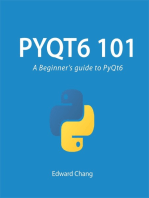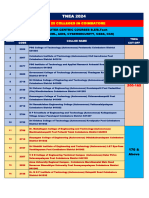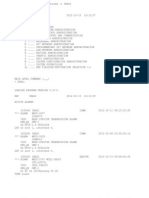Code
Uploaded by
Anonymous BeaverCode
Uploaded by
Anonymous Beaverfairmotion provides easy-to-use interfaces and tools to work with motion capture
data. The objective of the library is to manage the complexity of motion
representation, 3D transformations, file formats and visualization, and let users
focus on high level learning tasks.
Users can take advantage of large high-quality motion capture datasets like the CMU
and AMASS datasets without deep knowledge of the domain or handling the
idiosyncrasies of individual datasets. We implement baselines for research tasks
using building blocks from the library to demonstrate its utility.
Getting Started
Installation
farmotion is available on PyPI for easy installation
pip install fairmotion
To install fairmotion from source, first clone the git repository, use pip to
download dependencies and build the project.
$ git clone https://github.com/facebookresearch/fairmotion.git
$ cd fairmotion
$ pip install -e .
Data Loading
Here, we load a motion capture file in the BVH file format in a python console.
Similarly, there are loaders to import files from ASF/AMC, AMASS and AMASS DIP
formats.
from fairmotion.data import bvh
BVH_FILENAME = “PATH_TO_BVH_FILE”
motion = bvh.load(BVH_FILENAME)
Motion manipulation
The motion object can be manipulated in both modular and matrix forms. Here, we
translate the object to a fixed global position [1, 1, 1] and select a time slice
from frame 20 to frame 30.
from mocap_proceessing.ops import motion as motion_ops
translated_motion = motion_ops.translate(motion, np.array([1, 1, 1]))
sliced_motion = motion_ops.cut(translated_motion, 10, 20)
We can perform the same operations in the matrix representation of motion.
from fairmotion.core.motion import Motion
# motion_matrix has shape (num_frames, num_joints, 4, 4) where 4x4 is
transformation matrix
motion_matrix = motion.to_matrix()
translation_matrix = np.zeros((4, 4))
translation_matrix[3, :3] = np.array([1, 1, 1])
translated_motion_matrix = motion_matrix + translation_matrix
sliced_motion_matrix = translated_motion_matrix[10:20]
sliced_motion = Motion.from_matrix(sliced_motion_matrix, motion.skel)
Data saving
We can save the manipulated motion object back into the bvh file format for us to
visualize the result.
NEW_BVH_FILENAME = "PATH_TO_NEW_BVH_FILE"
bvh.save(sliced_motion, NEW_BVH_FILENAME)
Visualization
We visualize the results using the bvh_visualizer tool.
$ python fairmotion/viz/bvh_visualizer.py --bvh-files $NEW_BVH_FILENAME
Tasks
The tasks module showcases practical usage of fairmotion modules as building blocks
in developing projects.
Motion Prediction
Motion Graph
Clustering of motion capture dataset
Changepoint Detection
fairmotion has been used in some form in the following works:
Jungdam Won, Deepak Gopinath, and Jessica Hodgins. “A Scalable Approach to
Control Diverse Behaviors for Physically Simulated Characters” to be presented at
SIGGRAPH 2020 [Project page with code and paper]
Tanmay Shankar, and Abhinav Gupta. "Learning Robot Skills with Temporal
Variational Inference." ICML 2020
Jungdam Won, and Jehee Lee. "Learning body shape variation in physics-based
characters." ACM Transactions on Graphics (TOG) 2019
License
fairmotion is released under the BSD-3-Clause License.
You might also like
- IBM WebSphere Application Server Interview Questions You'll Most Likely Be AskedFrom EverandIBM WebSphere Application Server Interview Questions You'll Most Likely Be AskedNo ratings yet
- Installation and Configuration of IBM FileNet Information Management Software: A step-by-step guide to installing and configuring IBM FileNet ECM and Case Manager on RHEL 8.0 (English Edition)From EverandInstallation and Configuration of IBM FileNet Information Management Software: A step-by-step guide to installing and configuring IBM FileNet ECM and Case Manager on RHEL 8.0 (English Edition)No ratings yet
- 3.3.3.3 Packet Tracer 7 - Explore A NetworkNo ratings yet3.3.3.3 Packet Tracer 7 - Explore A Network3 pages
- Python Advanced Programming: The Guide to Learn Python Programming. Reference with Exercises and Samples About Dynamical Programming, Multithreading, Multiprocessing, Debugging, Testing and MoreFrom EverandPython Advanced Programming: The Guide to Learn Python Programming. Reference with Exercises and Samples About Dynamical Programming, Multithreading, Multiprocessing, Debugging, Testing and MoreNo ratings yet
- Firebase Storage for Angular: A reliable file upload solution for your applicationsFrom EverandFirebase Storage for Angular: A reliable file upload solution for your applicationsNo ratings yet
- Angular Generative AI: Building an intelligent CV enhancer with Google GeminiFrom EverandAngular Generative AI: Building an intelligent CV enhancer with Google GeminiNo ratings yet
- Mastering Go A Practical Guide to Developers: A Practical Guide to DevelopersFrom EverandMastering Go A Practical Guide to Developers: A Practical Guide to DevelopersMiguel Miranda de MattosNo ratings yet
- Aphelion Software: Unlocking Vision: Exploring the Depths of Aphelion SoftwareFrom EverandAphelion Software: Unlocking Vision: Exploring the Depths of Aphelion SoftwareNo ratings yet
- Hibernate, Spring & Struts Interview Questions You'll Most Likely Be AskedFrom EverandHibernate, Spring & Struts Interview Questions You'll Most Likely Be AskedNo ratings yet
- The Opencv User Guide: Release 2.4.13.1No ratings yetThe Opencv User Guide: Release 2.4.13.125 pages
- Python Performance Engineering: Strategies and Patterns for Optimized CodeFrom EverandPython Performance Engineering: Strategies and Patterns for Optimized CodeNo ratings yet
- Motion Estimation: Advancements and Applications in Computer VisionFrom EverandMotion Estimation: Advancements and Applications in Computer VisionNo ratings yet
- Video Processing Communications Yao Wang Chapter6cNo ratings yetVideo Processing Communications Yao Wang Chapter6c30 pages
- The Opencv User Guide: Release 2.4.0-BetaNo ratings yetThe Opencv User Guide: Release 2.4.0-Beta23 pages
- Factorized Motion Diffusion for Precise and Character Agnostic Motion Inbetweening PaperNo ratings yetFactorized Motion Diffusion for Precise and Character Agnostic Motion Inbetweening Paper15 pages
- Implementing Motion Markov Detection On General Purpose Processor and Associative MeshNo ratings yetImplementing Motion Markov Detection On General Purpose Processor and Associative Mesh6 pages
- Lab Manual: Department of Computer Science & EngineeringNo ratings yetLab Manual: Department of Computer Science & Engineering26 pages
- Visualizing Deep Neural Networks Classes and Features - AnkivilNo ratings yetVisualizing Deep Neural Networks Classes and Features - Ankivil58 pages
- Spring Boot Intermediate Microservices: Resilient Microservices with Spring Boot 2 and Spring CloudFrom EverandSpring Boot Intermediate Microservices: Resilient Microservices with Spring Boot 2 and Spring CloudNo ratings yet
- The Designer’s Guide to Figma: Master Prototyping, Collaboration, Handoff, and WorkflowFrom EverandThe Designer’s Guide to Figma: Master Prototyping, Collaboration, Handoff, and Workflow3/5 (1)
- Visual SourceSafe 2005 Software Configuration Management in PracticeFrom EverandVisual SourceSafe 2005 Software Configuration Management in PracticeNo ratings yet
- Image Registration: 1 Problem DescriptionNo ratings yetImage Registration: 1 Problem Description10 pages
- Open Source Computer Vision Library: Reference Manual100% (3)Open Source Computer Vision Library: Reference Manual436 pages
- CS 664 Slides #7 Visual Motion: Prof. Dan Huttenlocher Fall 2003No ratings yetCS 664 Slides #7 Visual Motion: Prof. Dan Huttenlocher Fall 200332 pages
- Seamless Human Motion Composition With Blended Positional EncodingsNo ratings yetSeamless Human Motion Composition With Blended Positional Encodings20 pages
- Pytorch Waste Classification Using Densenet Jupyter NotebookNo ratings yetPytorch Waste Classification Using Densenet Jupyter Notebook14 pages
- Redmine Implementation Cookbook Final PDFNo ratings yetRedmine Implementation Cookbook Final PDF28 pages
- Bluetooth Controlled Arduino Notice BoardNo ratings yetBluetooth Controlled Arduino Notice Board6 pages
- Introduction To Electronics, Familiarization With Basic Electronic Components and Measuring Instruments.100% (1)Introduction To Electronics, Familiarization With Basic Electronic Components and Measuring Instruments.46 pages
- Airbus Incremental Development GuidebookNo ratings yetAirbus Incremental Development Guidebook52 pages
- Conventional CMOS Latches and Flip Flops, Pulsed Latches, Resettable and Enabled Latches and Flip FlopsNo ratings yetConventional CMOS Latches and Flip Flops, Pulsed Latches, Resettable and Enabled Latches and Flip Flops52 pages
- Spare Parts: Boilers Type M, ME, MCS & CPI12No ratings yetSpare Parts: Boilers Type M, ME, MCS & CPI1218 pages
- HLK+LD2410+Life+Presence+Sensor+Module+Manual+V1 03 (220629)No ratings yetHLK+LD2410+Life+Presence+Sensor+Module+Manual+V1 03 (220629)16 pages
- A Comprehensive Guide To Create Blockchain in Python: Blockchain-Rising Development TrendNo ratings yetA Comprehensive Guide To Create Blockchain in Python: Blockchain-Rising Development Trend6 pages
- Protection of Transmission Line Using GPSNo ratings yetProtection of Transmission Line Using GPS13 pages
- Transformer, Three Phase - Wye - Delta or Y - Connection and Delta - Wye or - Y ConnectionNo ratings yetTransformer, Three Phase - Wye - Delta or Y - Connection and Delta - Wye or - Y Connection12 pages
- Theory and Language of Climate Change Communication: Brigitte Nerlich, Nelya Koteyko and Brian BrownNo ratings yetTheory and Language of Climate Change Communication: Brigitte Nerlich, Nelya Koteyko and Brian Brown14 pages

























































































